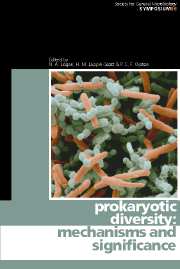Book contents
- Frontmatter
- Contents
- Contributors
- Editors' Preface
- Microbial diversity in the era of genomics
- Patterns in prokaryotic biodiversity
- A putative RNA-interference-based immune system in prokaryotes: the epitome of prokaryotic genomic diversity
- The significance of prokaryote diversity in the human gastrointestinal tract
- The genetics of phenotypic innovation
- Minimal genomes required for life
- Evolution of the core of genes
- Biogeographical diversity of archaeal viruses
- Is there a link between Chlamydia and heart disease?
- Unculturable oral bacteria
- Comparative genomics – what do such studies tell us about the emergence and spread of key pathogens?
- Spread of genomic islands between clinical and environmental strains
- Evolving gene clusters in soil bacteria
- Unusual micro-organisms from unusual habitats: hypersaline environments
- Genomic islands and evolution of catabolic pathways
- Horizontal gene transfer and its role in the emergence of new phenotypes
- Index
Genomic islands and evolution of catabolic pathways
Published online by Cambridge University Press: 06 July 2010
- Frontmatter
- Contents
- Contributors
- Editors' Preface
- Microbial diversity in the era of genomics
- Patterns in prokaryotic biodiversity
- A putative RNA-interference-based immune system in prokaryotes: the epitome of prokaryotic genomic diversity
- The significance of prokaryote diversity in the human gastrointestinal tract
- The genetics of phenotypic innovation
- Minimal genomes required for life
- Evolution of the core of genes
- Biogeographical diversity of archaeal viruses
- Is there a link between Chlamydia and heart disease?
- Unculturable oral bacteria
- Comparative genomics – what do such studies tell us about the emergence and spread of key pathogens?
- Spread of genomic islands between clinical and environmental strains
- Evolving gene clusters in soil bacteria
- Unusual micro-organisms from unusual habitats: hypersaline environments
- Genomic islands and evolution of catabolic pathways
- Horizontal gene transfer and its role in the emergence of new phenotypes
- Index
Summary
INTRODUCTION
Evolution of catabolic pathways in bacteria is most often equivalent to ‘catabolic pathway expansion’ or ‘new acquisition of catabolic properties’, although in essence it could also mean loss or deletion. Even if we limit ourselves to this narrow interpretation, changes in the repertoire of catabolic functions of a bacterium are largely attributable to the activity of mobile genetic elements (van der Meer, 1997, 2002). Typically, mobile genetic elements may create new recombinations between previously disconnected DNA fragments, even from different bacterial origins, thus assembling bits and pieces together. Such recombinations are not necessarily needed to result in a single, smoothly transcribed new operon; any workable gene or fragment of genes within the boundaries of the new host cell may contribute to the catabolic expansion of functions (Dogra et al., 2004; Müller et al., 2004). Classical examples of evolutionarily ancient pathway expansions are the formation of the operons for toluene and xylene degradation in pseudomonads (Harayama et al., 1987; Harayama & Rekik, 1993; Greated et al., 2002). Observations of (most likely) very recent pathway expansions include the formation of pathways for chlorobenzene degradation, such as in Pseudomonas sp. strain P51 (van der Meer et al., 1991) and Ralstonia sp. strain JS705 (van der Meer et al., 1998; Müller et al., 2003), or pathways for 2,4-dichloro-phenoxyacetic acid degradation in Ralstonia eutropha (now Cupriavidus necator) JMP134 (Laemmli et al., 2000; Trefault et al., 2004).
- Type
- Chapter
- Information
- Prokaryotic DiversityMechanisms and Significance, pp. 255 - 274Publisher: Cambridge University PressPrint publication year: 2006
- 3
- Cited by



